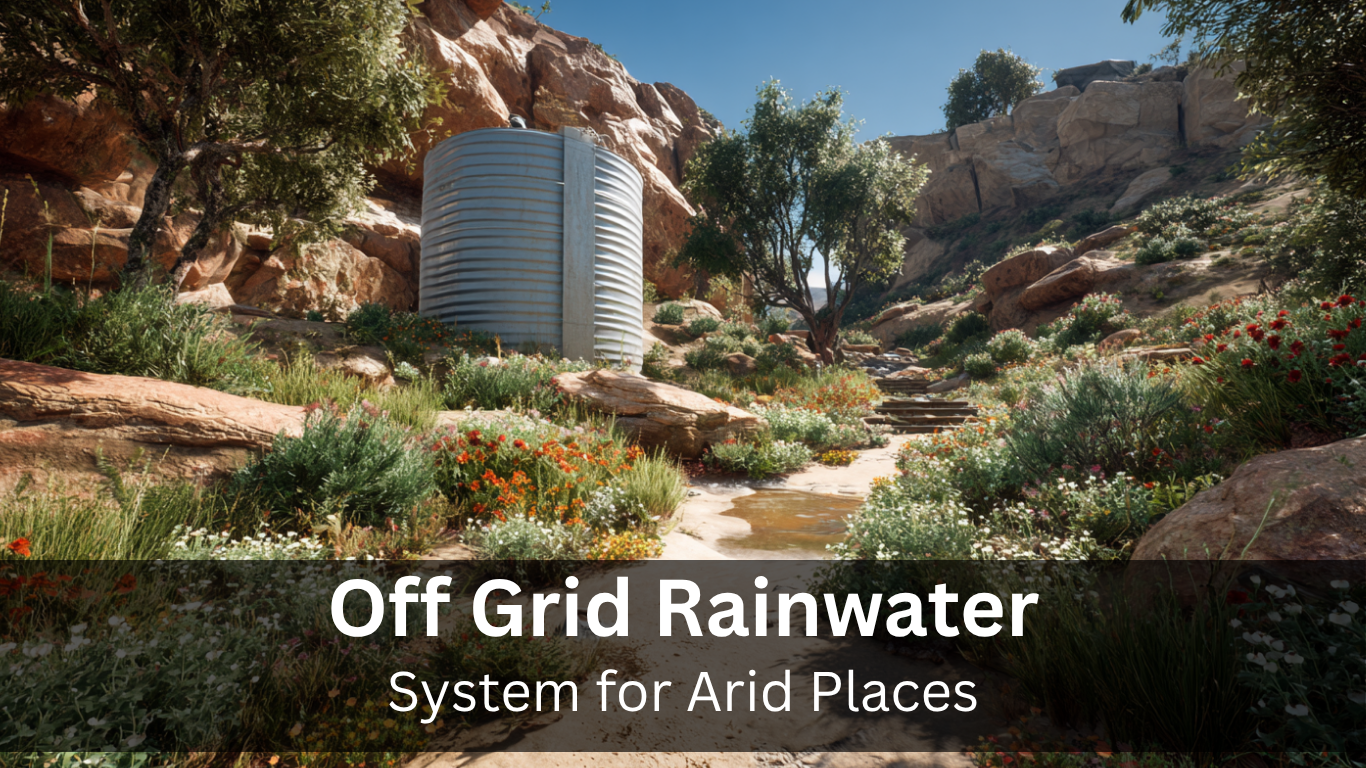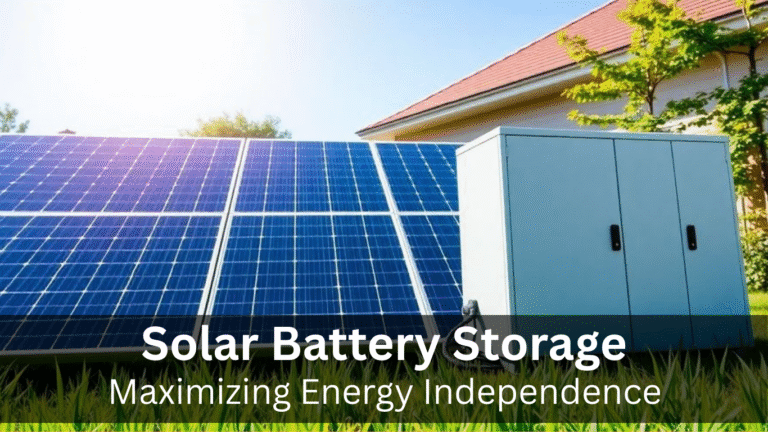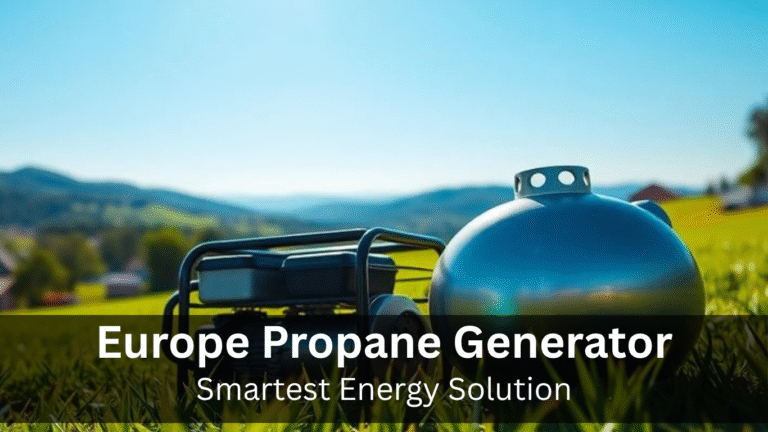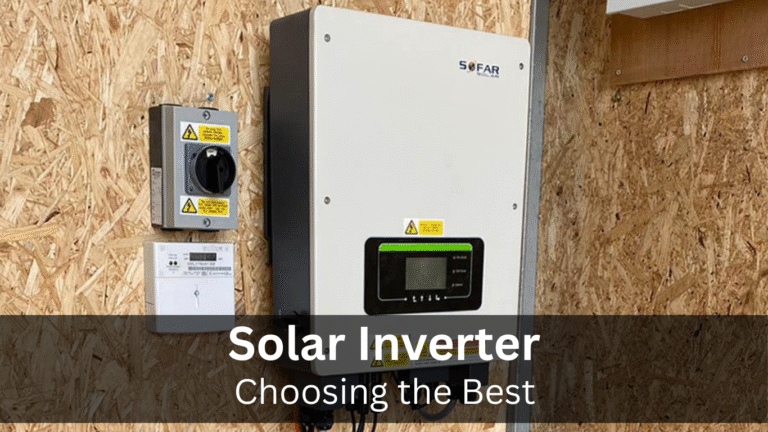How to Build an Off Grid Rainwater System in Arid Places
Living off the grid in dry places can be tough, especially when it comes to getting enough water. But guess what? Rainwater can be a real game-changer. This article will walk you through how to set up an Off Grid Rainwater system that actually works, even when it doesn’t rain much. We’ll cover everything from catching the rain to making sure it’s clean enough to use.
Key Takeaways
- Off Grid Rainwater systems help you get water without relying on city hookups.
- It’s smart to pick the right water source, like rainwater, for your off-grid setup.
- You need to plan how much water you’ll use and how much you can collect.
- Picking the right parts and putting them together correctly is super important for your system.
- Keeping your Off Grid Rainwater system clean and checking it often makes sure it keeps working well.
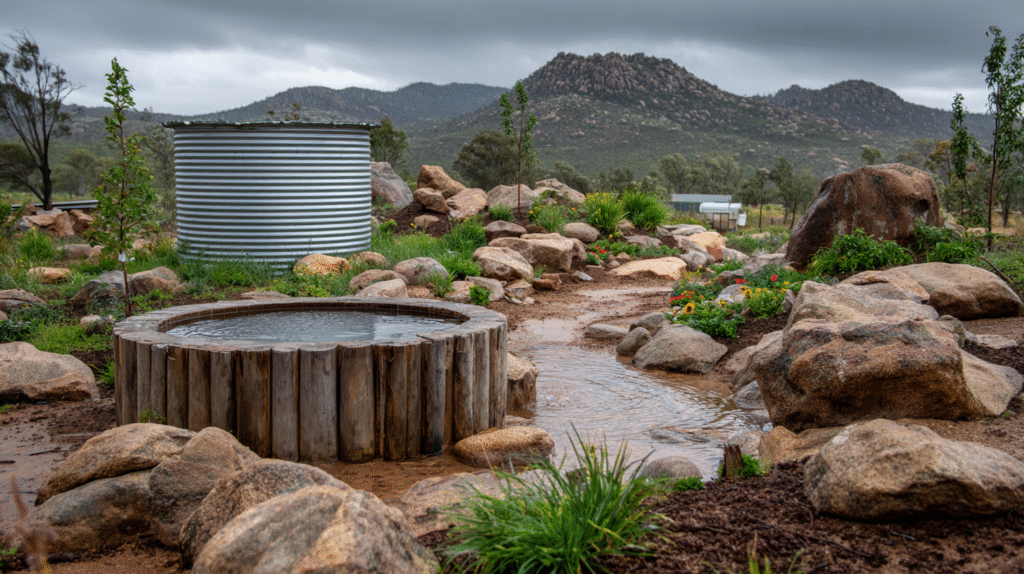
Understanding Off Grid Rainwater Sources
Groundwater Versus Surface Water
When you’re thinking about off grid water solutions, the first thing to figure out is where your water will come from. Usually, it’s either groundwater or surface water. Groundwater is what you get from wells or springs. It’s often cleaner because the earth filters it, but shallow wells can still get polluted. Surface water, like from rivers and lakes, is easier to get to, but it usually needs more cleaning before you can use it. Choosing the right source depends a lot on where you are and what your needs are.
Rainwater Harvesting Advantages
Rainwater harvesting offers a sustainable and independent water source, especially valuable in arid regions. It’s basically collecting rainwater and storing it for later. One of the best things about it is that you’re not relying on a municipal water supply, which can save you money and give you more control over your water. Plus, it’s a pretty green way to get water, reducing your environmental impact. For those in rainwater harvesting desert areas, this can be a game changer.
- Reduces reliance on municipal water.
- Environmentally friendly.
- Cost-effective in the long run.
Rainwater harvesting can be a great way to supplement your water supply, especially if you live in an area with frequent rainfall. It’s important to set up your system correctly and maintain it regularly to ensure the water is safe to use.
Assessing Water Quality and Flow
Before you commit to any water source, you need to check how good the water quality is and how much water you can actually get. For rainwater, this means looking at how much it rains in your area and testing the water for any pollution. For wells or surface water, you’ll want to test for things like bacteria, minerals, and other contaminants. Knowing the flow rate is also key – you need to make sure you’re getting enough water to meet your needs. Consider using water filters to ensure water safety. This is super important for sustainable water arid regions, where water is already scarce.
Designing Your Off Grid Rainwater System
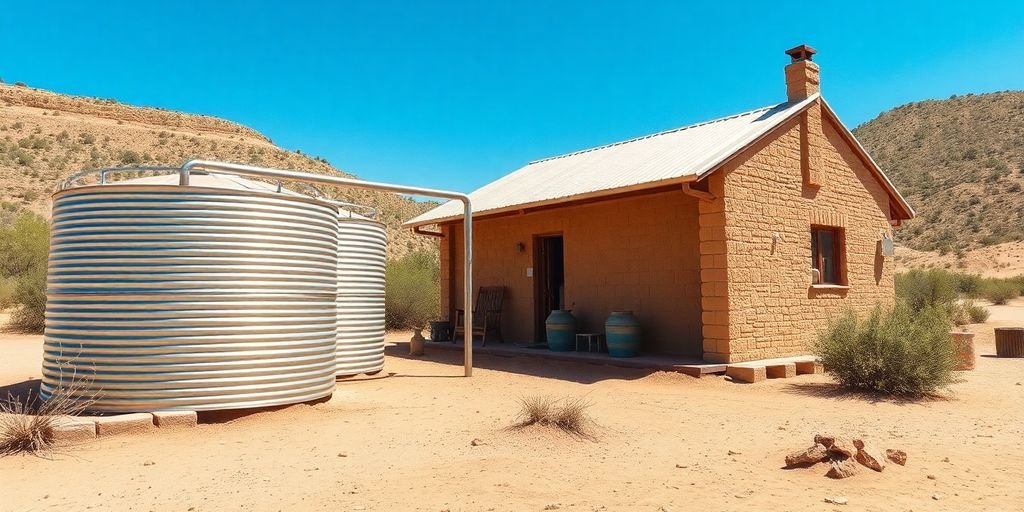
Planning for Water Security
Planning for water security in rainwater collection systems dry climates is all about understanding your needs and the resources available. It’s not just about collecting water when it rains; it’s about ensuring you have enough water to last through dry spells. Start by assessing your current water usage and identifying areas where you can conserve. Think about things like low-flow showerheads, efficient toilets, and drought-resistant landscaping.
- Evaluate your current water consumption.
- Identify water conservation strategies.
- Research local rainfall patterns and drought history.
Consider the long-term implications of climate change on your water supply. What might rainfall patterns look like in 10, 20, or 50 years? Planning for these uncertainties now can save you a lot of trouble down the road.
Calculating Supply and Demand
Calculating your water supply and demand is a critical step. You need to know how much water you can realistically collect and how much you’ll need to use. Start by determining the catchment area of your roof. Then, factor in average rainfall for your area. Don’t forget to account for losses due to evaporation and first flush diversion. On the demand side, consider all your water uses, from drinking and cooking to bathing and gardening.
| Use | Estimated Daily Consumption (Gallons) |
|---|---|
| Drinking/Cooking | 2-5 |
| Toilet Flushing | 3-6 per flush |
| Showering | 2-5 per minute |
| Gardening | Varies widely |
Material Selection for Durability
Choosing the right materials is key to a long-lasting and reliable rainwater harvesting system. Consider the climate, the quality of the water, and your budget. For tanks, options include polyethylene, fiberglass, and concrete. Polyethylene is lightweight and affordable, but it may not be as durable as other options. Fiberglass is strong and corrosion-resistant, but it can be more expensive. Concrete is very durable, but it’s also heavy and requires a solid foundation. For pipes and fittings, PVC and CPVC are common choices. Make sure to select materials that are certified for potable water use.
- Tank Material: Polyethylene, Fiberglass, Concrete
- Piping: PVC, CPVC
- Fittings: Brass, Stainless Steel, Plastic
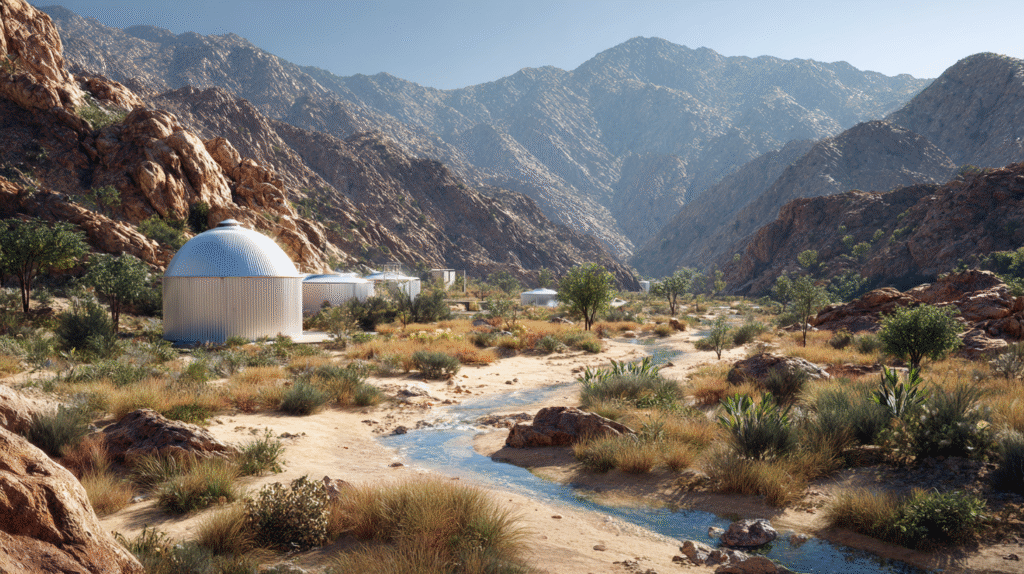
Essential Components for Off Grid Rainwater Collection
Gutter and Conveyance Sizing
Okay, so you’re thinking about setting up a rainwater collection system? Awesome! First things first, let’s talk gutters. Getting the right size for your gutters and downspouts is super important. You don’t want them overflowing during a heavy rain, which defeats the whole purpose. Think about the size of your roof and how much rain you typically get.
A bigger roof or more rainfall means you’ll need larger gutters and more downspouts. It’s better to go a little bigger than you think you need – trust me on this one. Also, make sure they’re sloped correctly so the water actually flows towards the downspouts. Nobody wants stagnant water sitting in their gutters. Proper gutter sizing prevents overflow and ensures efficient water collection.
Rain Barrel and Tank Options
Now, where are you going to store all that lovely rainwater? You’ve got options! Rain barrels are great for smaller setups, like watering your garden. They’re usually less expensive and easier to install. But if you’re planning to use rainwater for your whole house, you’ll probably need a bigger tank. Tanks come in all sorts of materials – plastic, metal, concrete. Plastic is lightweight and affordable, but metal is more durable.
Concrete is super strong but can be a pain to move around. Think about how much water you need to store, how much space you have, and your budget. Also, consider whether you want an above-ground or below-ground tank. Below-ground tanks keep the water cooler and out of sight, but they’re more work to install. The material you choose impacts durability and cost.
Pre-Filtration and Filtration Methods
Alright, let’s talk about keeping that rainwater clean. You don’t want to be drinking water full of leaves and bird poop, right? That’s where filtration comes in. Pre-filtration is your first line of defense. This usually involves a screen or filter basket to catch big stuff like leaves and twigs before they even get to your tank. Then, you’ll want a finer filter to remove smaller particles.
There are lots of different types of filters out there, from simple sediment filters to fancy UV filters that kill bacteria. If you’re using the water for drinking, you’ll definitely want to invest in a good filtration system. Think about a multi-stage approach: a sediment filter, then a carbon filter, and maybe even a UV filter for extra peace of mind. Regular filtration methods are key to safe water.
Setting up a rainwater harvesting system can seem daunting, but it’s totally doable. Just take it one step at a time, do your research, and don’t be afraid to ask for help. And remember, clean water is worth the effort!
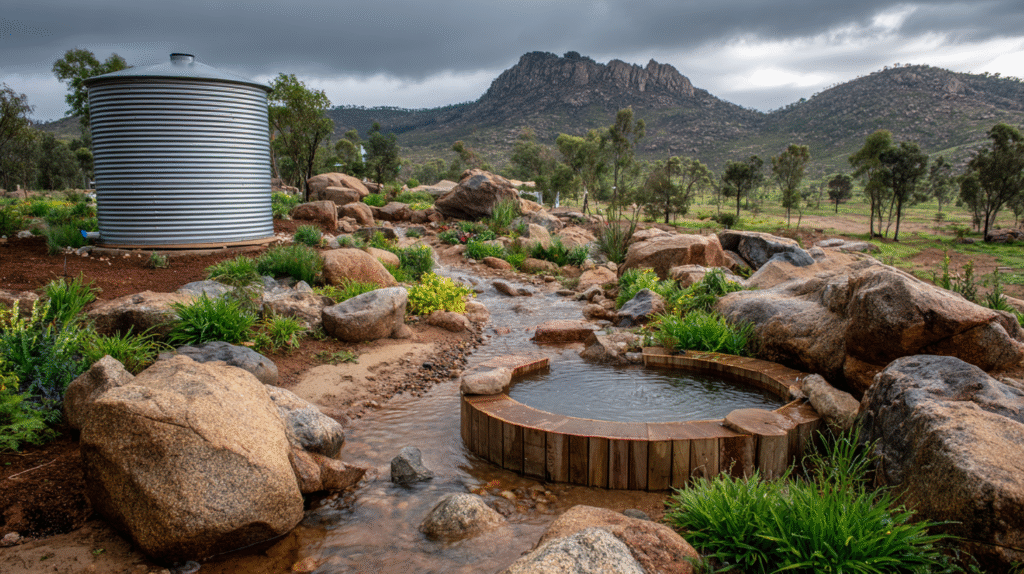
Implementing Your Off Grid Rainwater Setup
Installing Collection Systems
Okay, so you’ve got your plan, you’ve got your materials, now it’s time to actually put this rainwater harvesting system together. First things first, you need to think about your catchment area. This is usually your roof, and it needs to be as clean as possible. You don’t want leaves, bird droppings, or anything else nasty washing into your storage tanks.
Here’s a basic rundown:
- Clean the Roof: Seriously, give it a good sweep or even a wash.
- Install Gutters: Make sure they’re properly sloped so the water actually flows towards the downspouts.
- Attach Downspouts: Connect these to your collection point, whether it’s a tank or a first-flush diverter.
Setting Up Storage Solutions
Now for the big one: the storage. Your storage solution is the heart of your off-grid rainwater system. You’ve got a few options here, from small rain barrels to large tanks. The size you need depends on your water usage and how much rain you get.
Things to consider:
- Tank Material: Plastic, concrete, or metal – each has pros and cons.
- Tank Size: Calculate your needs carefully. Err on the side of too big rather than too small.
- Placement: Above ground or below ground? Think about space, aesthetics, and temperature control.
Make sure your tanks are properly sealed to prevent contamination and evaporation. You might also want to consider insulating them if you live in a place with extreme temperatures.
Connecting to Household Water
Alright, you’re collecting rainwater, you’re storing it, now you need to actually use it. This is where things can get a little more complicated, especially if you’re connecting to your existing plumbing. You’ll likely need a pump to get the water pressure high enough, and you’ll definitely need a filtration system to make sure the water is safe to drink (if that’s your plan).
Here’s what you’ll need to think about:
- Pump Selection: Get the right size pump for your needs. Too small and you won’t have enough pressure; too big and you’ll waste energy.
- Plumbing Connections: Make sure everything is properly sealed and up to code.
- Backflow Prevention: This is crucial to prevent contaminated water from flowing back into the main water supply.
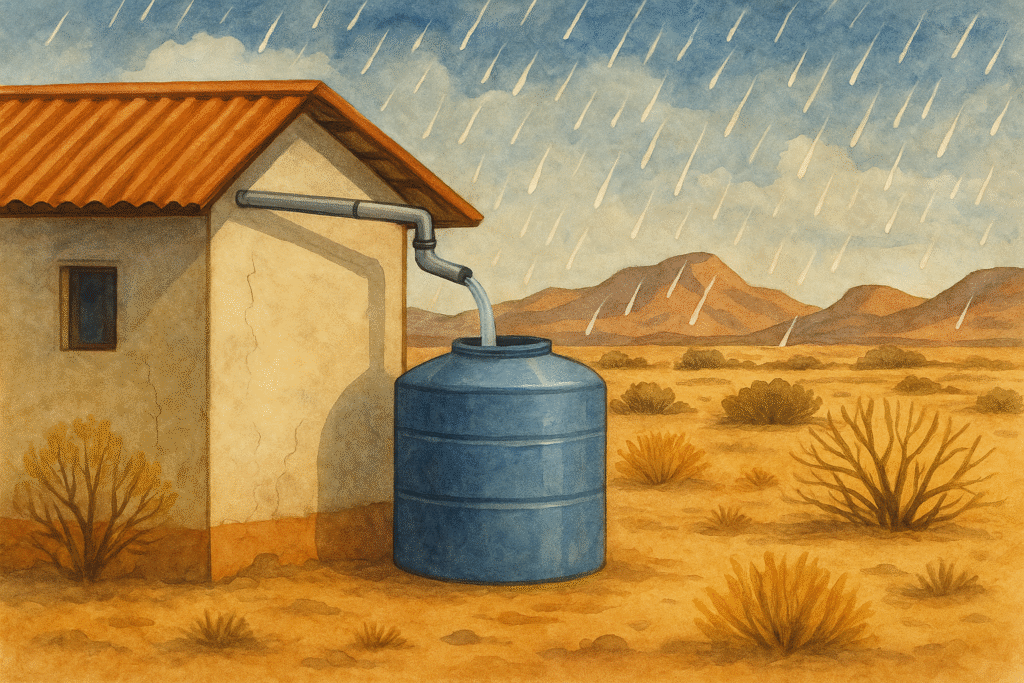
Maintaining Your Off Grid Rainwater System
Regular Inspection and Cleaning
Okay, so you’ve got your rainwater harvesting system up and running. Great! But don’t just set it and forget it. Regular maintenance is key to keeping your water clean and your system working efficiently. Think of it like your car – you wouldn’t skip oil changes, right? The same goes for your rainwater setup. I usually try to do a quick check at least once a month, and a more thorough cleaning every few months. This is especially important after big storms, which can bring in a lot of debris.
Here’s a simple checklist I use:
- Check gutters for leaves and twigs.
- Inspect screens and filters for clogs.
- Look for any leaks in the tank or pipes.
It’s easy to overlook maintenance, but trust me, a little bit of upkeep now can save you a lot of headaches (and potentially costly repairs) down the road. Plus, you’ll have peace of mind knowing your water is as clean as possible.
Preventing Blockages and Damage
Blockages are the enemy of any rainwater harvesting system. Leaves, twigs, and even small animals can find their way into your gutters and pipes, causing clogs that reduce the amount of water you collect. Prevention is the best medicine here. I use gutter guards to keep out larger debris, and I regularly flush out my downspouts with a hose. Also, make sure your storage tank is properly sealed to prevent insects and other critters from getting in.
Here’s a quick table showing common issues and how to prevent them:
| Issue | Prevention Method |
|---|---|
| Clogged Gutters | Install gutter guards, regular cleaning |
| Leaky Pipes | Use durable materials, check connections regularly |
| Tank Contamination | Seal tank properly, use a first flush diverter |
Don’t forget to protect your system from physical damage, too. If you live in an area with harsh weather, consider insulating your pipes to prevent freezing and cracking. And if you have an above-ground tank, make sure it’s properly secured to prevent it from tipping over in strong winds. You can choose the right storage tanks for your needs.
Ensuring Water Potability
This is the big one. Just because you’re collecting rainwater doesn’t automatically mean it’s safe to drink. Rainwater can pick up contaminants from your roof, gutters, and even the air. That’s why proper filtration and disinfection are so important. I use a multi-stage filtration system that includes a sediment filter, a carbon filter, and a UV sterilizer. This removes any debris, chemicals, and bacteria that might be present in the water.
Here are some steps to ensure your water is potable:
- Regularly test your water for bacteria and other contaminants.
- Replace filters according to the manufacturer’s instructions.
- Consider adding a disinfection method, such as UV sterilization or chlorination.
It’s also a good idea to have a backup water source in case your rainwater system fails or your water tests come back with concerning results. Better safe than sorry!
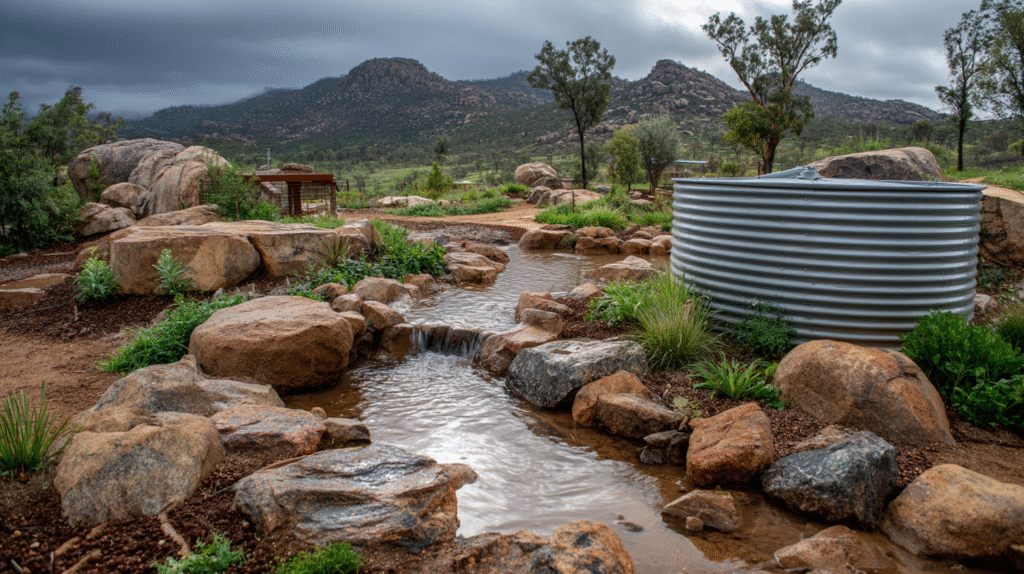
Advanced Off Grid Rainwater Treatment
Multi-Barrier Treatment Approaches
When it comes to desert rainwater collection, you can’t be too careful. A single filter just won’t cut it. That’s why a multi-barrier approach is the way to go. Think of it like layers of defense, each targeting different contaminants. This could mean a sediment filter to get rid of the big stuff, followed by a carbon filter to tackle taste and odor, and then maybe a UV sterilizer to zap any remaining bacteria. It’s all about redundancy and making sure your water is as clean as possible.
Disinfection and Neutralization
Disinfection is a must, especially if you’re planning on drinking the water. UV light is a popular choice, but you could also consider chlorination or ozonation. Neutralization comes into play if your rainwater is too acidic, which can happen depending on the environment. Acidic water can corrode pipes and leach metals, so you might need to add a neutralizing filter to bring the pH back to a safe level.
Ion Exchange for Water Quality
Ion exchange is a more advanced treatment method that can target specific contaminants, like nitrates or heavy metals. It works by swapping unwanted ions in the water with harmless ones. It’s a bit more complex than basic filtration, but it can make a big difference in water quality, especially if you’re dealing with smart rainwater harvesting in areas with specific pollution concerns.
Setting up a rainwater harvesting system is a big project, but it’s worth it. You’re not just collecting water; you’re creating a more sustainable way of life. It’s about being prepared and taking control of your water supply.
Here’s a simple breakdown of potential treatment stages:
- Sediment Filtration
- Carbon Filtration
- UV Sterilization
- Ion Exchange
Integrating Off Grid Rainwater with Other Systems
Rainwater for Irrigation and Toilets
Okay, so you’ve got your rainwater harvesting system up and running. What’s next? Well, one of the smartest things you can do is think about how to use that water for more than just drinking. Think about irrigation and toilets. Using rainwater for these purposes can seriously cut down on your overall water consumption.
- Toilets: Flushing toilets uses a surprising amount of water. By connecting your rainwater tank to your toilet, you can save a ton of water. Just make sure you have the right filtration in place.
- Irrigation: Rainwater is naturally soft and free of chemicals, making it great for your garden. You can set up a simple gravity-fed system or use a pump to distribute the water.
- Consider the annual rainfall in your area to determine how much you can rely on rainwater for these uses.
Gray Water Recycling Integration
Another excellent method for maximizing water usage is gray water recycling. This type of water refers to wastewater from sources like showers, sinks, and washing machines—essentially everything except toilet water. The idea is to treat this water and reuse it for things like irrigation or flushing toilets.
Integrating your rainwater system with a gray water system can create a super efficient setup. For example, if you don’t have enough rainwater, you can supplement it with treated gray water. It’s all about finding the right balance and making the most of every drop.
Integrating rainwater harvesting with gray water recycling can significantly reduce your reliance on traditional water sources. It’s a win-win for your wallet and the environment.
Recharging Regional Aquifers
This is where things get really interesting. Instead of just using the rainwater for your own needs, you can actually help replenish the groundwater supply. This is especially important in arid regions where water is scarce.
How do you do it? Basically, you create a system that directs excess rainwater back into the ground. This can involve things like:
- Infiltration basins: These are shallow depressions that allow water to slowly soak into the ground.
- Dry wells: These are underground structures that channel water directly into the aquifer.
- Permeable pavements: These allow rainwater to seep through the surface instead of running off.
By recharging aquifers, you’re not just helping yourself – you’re helping the entire community. It’s a long-term solution that can make a real difference. You can even look into rainwater filters to ensure the water is clean before it recharges the aquifer.
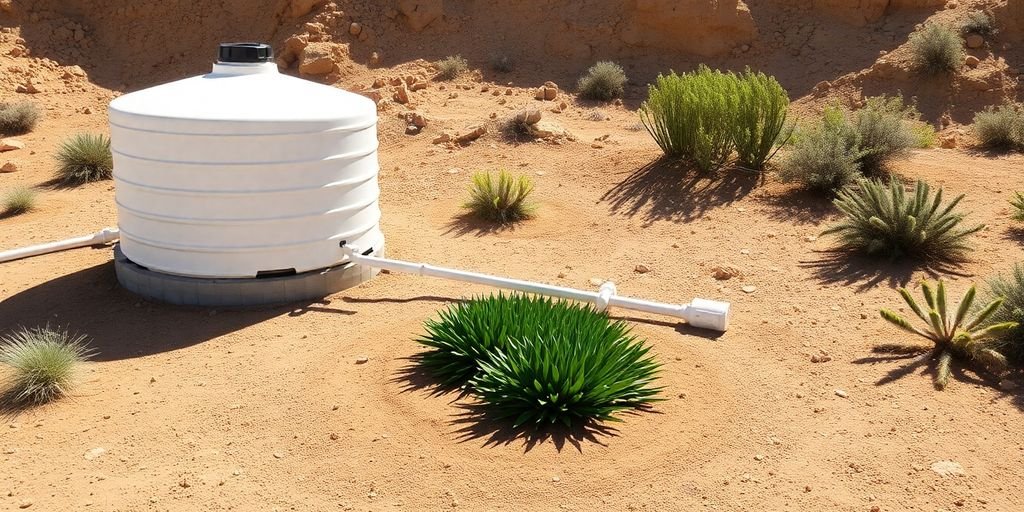
Wrapping Things Up
So, there you have it. Setting up your own off-grid rainwater system, especially in dry places, is totally doable. It’s not just about saving money on water bills, though that’s a nice perk. It’s also about being ready for anything, like when the city water goes out, or just doing your part for the planet. Sure, it takes some thought and planning, but knowing you’ve got your own water supply, come what may, is a pretty good feeling. It’s a smart move for anyone wanting a bit more independence and a smaller footprint.
Frequently Asked Questions
What is an off-grid water system?
An off-grid water system is a self-sufficient setup that provides water without relying on city water lines. These systems often use wells, natural springs, or collected rainwater.
What are the best water sources when living off the grid?
When living off the grid, common water sources include private wells, collected rainwater, natural springs, and nearby surface water. Each of these will need different ways to clean the water.
Do I need a water filter for a system like this?
Yes, cleaning the water is very important. You need to filter out dirt, germs, and other bad stuff, especially when using water from natural places that haven’t been treated.
How should I store water in a remote location?
You can store water in large tanks, food-grade containers, or underground storage areas. Make sure they are sealed, kept out of the sun, and cleaned regularly to keep the water safe.
What type of water pump works best without access to power?
If you don’t have electricity, solar-powered pumps, hand pumps, or systems that use gravity (where water flows downhill) are good choices. The best one depends on how high up your water source is and how much water you need each day.
Is rainwater safe to drink?
Rainwater can be safe to drink, but only after it has been properly filtered and cleaned. You usually need several steps to treat it, like filtering, killing germs, and sometimes adding things to make sure it’s completely safe.

